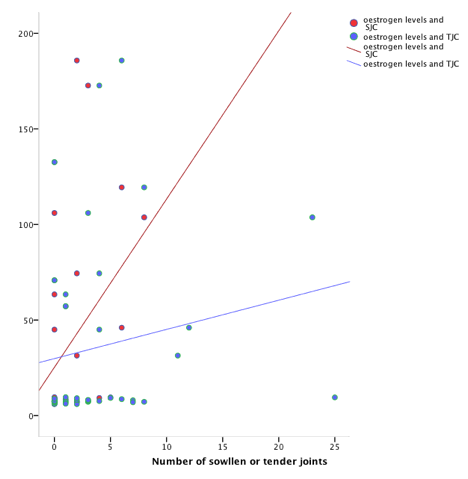Session Information
Date: Monday, October 22, 2018
Title: Rheumatoid Arthritis – Diagnosis, Manifestations, and Outcomes Poster II: Diagnosis and Prognosis
Session Type: ACR Poster Session B
Session Time: 9:00AM-11:00AM
Background/Purpose:
Rheumatoid arthritis (RA) is an autoimmune and inflammatory polyarthritis involving mainly the synovial joints, and causing destruction of the articular cartilage and disabilities. Leflunomide is one of the anti-proliferative drugs proved to be effective in controlling the disease by suppressing the inflammatory cytokines and inducing apoptotic genes in synovial macrophages. However, regulation of the disease seems to be complex where the sex hormone, oestrogen, is incriminated in counteracting the effect of leflunomide in vitro. Moreover, detected oestrogen receptors polymorphisms were supposed to play a role in disease resistance. We aimed in this study to unravel the relationship between oestrogen levels and leflunomide outcome in RA.
Methods:
RA patients fulfilling the ACR/EULAR 2010 RA criteria and receiving only leflunomide (20 mg daily) and hydroxychloroquine were gathered from the outpatient clinics after being consented. Disease activity of the patients was evaluated by the disease activity score (DAS)-28 and the clinical disease activity index (CDAI). Serum oestrogen levels were detected by enzyme-linked immunosorbent assay (ELISA). Descriptive and correlation studies were used as appropriated.
Results:
RA patients (n=50) were recruited. 98% were females and mean age was 47.2±10.3 years. Median (IQR) levels of oestrogen were 8.6 (7.4- 50.5) IU/mL. Minimal and maximal levels of oestrogen were 6 IU/mL and 185.5 IU/mL respectively. Values of DAS-28 and CDAI did not correlate with oestrogen levels. Neither the patientÕs global assessment using 100 mm visual analogue scale nor the erythrocyte sedimentation rate correlated with oestrogen levels. Contrarily, swollen joint count (SJC) and tender joint count (TJC) correlated positively with oestrogen levels (rho=.433, p=.006 and rho=.33, p=.04 respectively) as shown in Fig 1.
Conclusion:
The changes in oestrogen levels among RA patients could be responsible for the different outcome of leflunomide therapy in these patients. Further studies on bigger cohorts and longitudinal observations are required.
Fig.1 Correlations between oestrogen levels and the number of swollen or tender joints
To cite this abstract in AMA style:
Mohamed AAA, Hassanien M, Ahmed EA. Oestrogen Levels and the Outcome of Leflunomide Treatment in Rheumatoid Arthritis [abstract]. Arthritis Rheumatol. 2018; 70 (suppl 9). https://acrabstracts.org/abstract/oestrogen-levels-and-the-outcome-of-leflunomide-treatment-in-rheumatoid-arthritis/. Accessed .« Back to 2018 ACR/ARHP Annual Meeting
ACR Meeting Abstracts - https://acrabstracts.org/abstract/oestrogen-levels-and-the-outcome-of-leflunomide-treatment-in-rheumatoid-arthritis/

